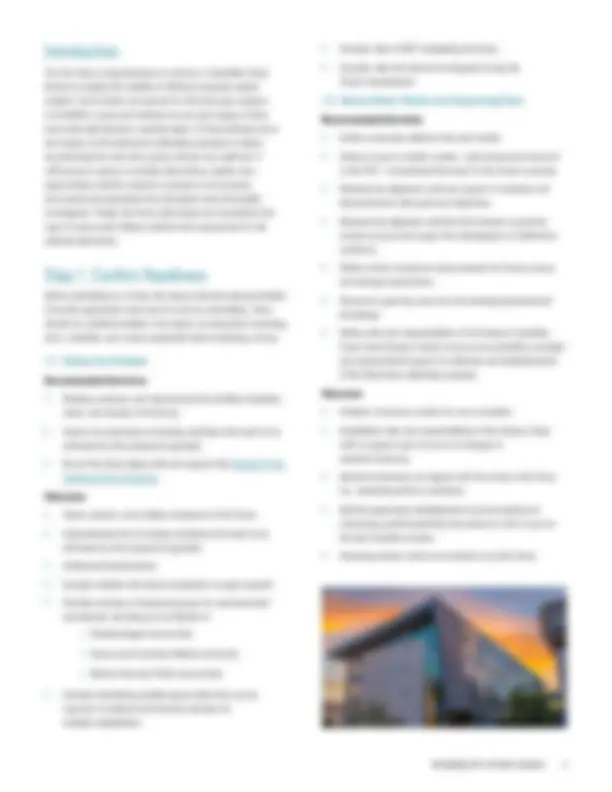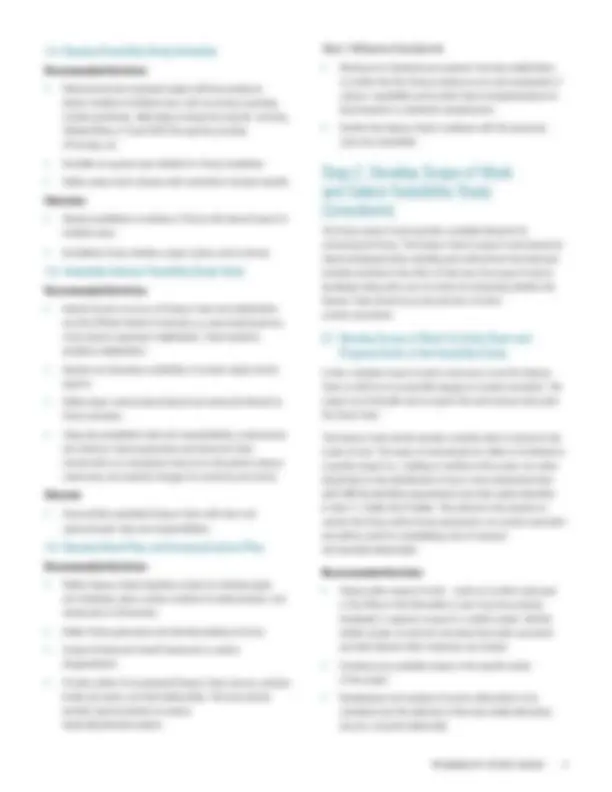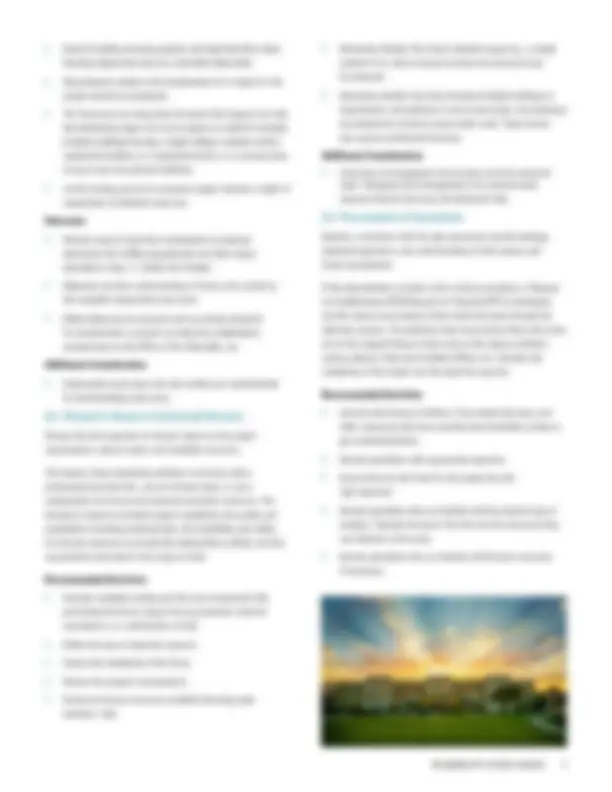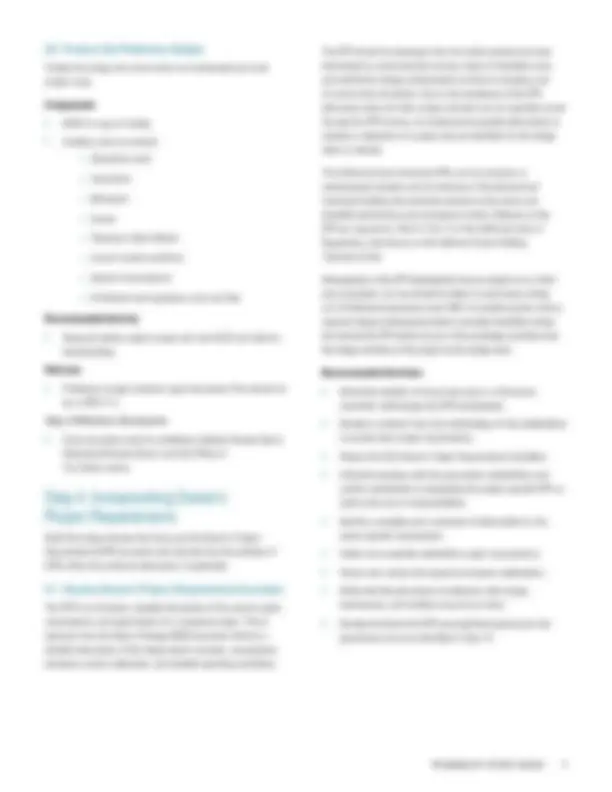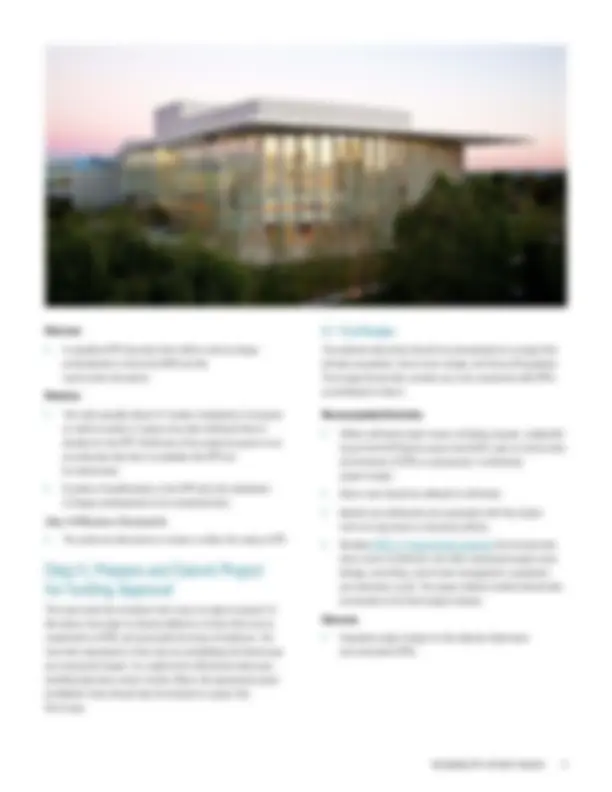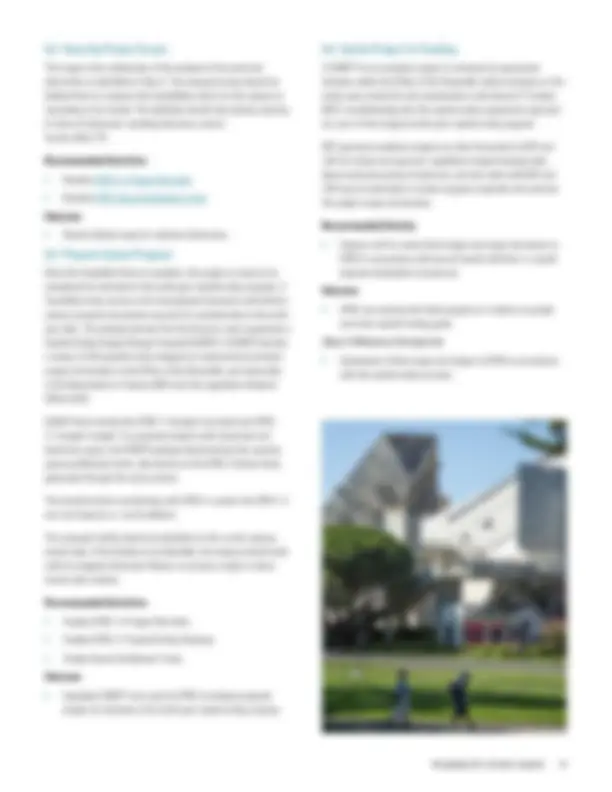Download Feasibility Study Guide: Conducting a Successful Capital Project Feasibility Study and more Exams Construction in PDF only on Docsity!
FEASIBILITY STUDY GUIDE
From concept through funding request submittal, this resource
document provides support to CSU campus staff charged with
conducting a feasibility study.
JULY 2021
TABLE OF CONTENTS
1.3 Develop Feasibility Study Schedule
Recommended Activities
- Demonstrate how proposed project will have maximum impact, ideally in multiple areas, such as serving a growing student population, alleviating an impacted program, reducing Vehicle Miles of Travel (VMT) through the provision of housing, etc.
- Establish an agreed-upon timeline for Study completion.
- Define cycles and/or phases with waterfall or iterative models.
Outcomes
- Clearly established correlation of Study with desired impact in multiple areas.
- Established Study timeline, project cycles, and/or phases.
1.4 Assemble Campus Feasibility Study Team
Recommended Activities
- Identify Study’s structure of Campus Team and stakeholders and the different levels of interests e.g. executives/sponsors; study owners; key/major stakeholders; Team members; periphery stakeholders.
- Identify and determine availability of outside subject matter experts.
- Define larger communities (internal and external) affected by Study outcomes.
- Using the established roles and responsibilities, communicate and reinforce Team expectations and share the Team contacts list as a transparent resource to the greater campus community, and maintain changes for continuity and clarity.
Outcome
- Successfully assembled Campus Team with clear and communicated roles and responsibilities.
1.5 Develop Work Plan and Communications Plan
Recommended Activities
- Define Campus Team’s logistics process for meeting types and attendees, plans, actions, method of communication, and distribution of information.
- Define Study governance and decision-making structure.
- Create informal and formal framework to resolve disagreements.
- Provide outline for incremental Campus Team outputs, decision levels and points, and final deliverables. This may include periodic reports/updates to campus leadership/decision makers.
Step 1: Milestone Checkpoints
- Distribute for feedback and comment from key stakeholders to confirm that the Study provides an accurate assessment of campus’ capabilities and provide Team recommendations for improvements or additional considerations.
- Confirm the Campus Team’s readiness with the necessary resources assembled.
Step 2. Develop Scope of Work
and Select Feasibility Study
Consultants
The Study scope of work provides a detailed blueprint for conducting the Study. The Campus Team’s scope of work should be clearly developed before deciding who will perform the individual activities involved in the effort. In this step, the scope of work is developed along with a set of criteria for evaluating whether the Campus Team should be purely internal or include outside consultants.
2.1 Develop Scope of Work for Study Team and
Program Goals of the Feasibility Study
A clear, complete scope of work is necessary to aid the Campus Team as well as to successfully engage an outside consultant. The scope is an invaluable tool to support the work process and guide the Study Team.
The Campus Team should consider carefully what to include in the scope of work. The scope of work should not reflect or be limited to a specific project (i.e., building or facility) at the outset, but rather should lead to the identification of one or more alternatives that will fulfill the identified programmatic and other needs identified in Step 1.1, Define the Problem. This will aid in the decision to conduct the Study with in-house personnel or an outside consultant and will be useful for establishing a list of required and desirable deliverables.
Recommended Activities
- Review other scopes of work – reach out to other campuses or the Office of the Chancellor to see if any have already developed or possess a scope for a similar project. Identify similar scopes of work and outcomes have been successful and what lessons other campuses can provide.
- Customize any available scopes to the specific needs of the project.
- Development and analysis of various alternatives to be considered and the selection of the most viable alternative may be a required deliverable.
- General building massing graphics and high-level floor plans showing adjacencies may be a desirable deliverable.
- Requirements related to the development of a budget for the project should be considered.
- The Study may be a long-lived document that impacts not only the immediate project but future projects as well (for example, multiple buildings housing a single college, multiple student residential facilities or a residential district, or a concentration of sports and recreational facilities).
- Justify funding priority for proposed project solution, in light of competition for (limited) resources.
Outcomes
- Written scope of work that recommends a proposed alternative that fulfills programmatic and other needs identified in Step 1.1, Define the Problem.
- Objective and clear understanding of Study costs, based on the compiled comparable study costs.
- Deliverables may be required such as printed materials for presentations, outreach to community stakeholders, presentations to the Office of the Chancellor, etc.
Additional Consideration
- Comparable study costs and case studies are recommended for benchmarking study costs.
2.2 Choose In-House or Contracted Services
Choose the best expertise for the job, based on the project requirements, campus needs, and available resources.
The Campus Team determines whether to contract with a professional services firm, use an in-house team, or use a combination of in-house and external consultant resources. The decision is based on possible project complexity, the quality and availability of existing technical data, the availability and ability of in-house resources to provide the deliverables outlined, and the requirements described in the scope of work.
Recommended Activities
- Consider available funding and the costs associated with performing the Study using in-house personnel, external consultants, or a combination of both.
- Define the type of expertise required.
- Assess the complexity of the Study.
- Review the project’s requirements.
- Evaluate in-house resources available including team members’ time. - Determine whether the Study is limited scope (e.g., a single system). If so, then in-house services and resources may be adequate. - Determine whether the Study involves multiple buildings or departments, site selection or new construction, and extensive environmental or historic preservation work. These factors may require professional services. Additional Consideration - Avoid loss of management and process control to external team. Recognize that management of an external team requires internal resources and dedicated time.
2.3 Procurement of Consultants
Identify a consultant with the right personnel, local knowledge, technical experience, and understanding of both campus and Study requirements.
If the determination is made to hire a Study consultant, a Request for Qualifications (RFQ)/Request for Proposal (RFP) is developed, and the campus procurement officer leads the team through the selection process. The selection team may include others who were not on the original Campus Team such as the campus architect, campus planner, Executive Facilities Officer, etc. Consider the complexity of the project and the expertise required.
Recommended Activities
- Consult with Campus Architect, Procurement Services, and other campuses who have recently done feasibility studies to get recommendations.
- Include specialists with appropriate expertise.
- Ensure that any firm hired for the project has the right expertise.
- Include specialists who are familiar with the desired type of analysis. Consider the size of the firm and the resources they can dedicate to the study.
- Include specialists who are familiar with historic resources if necessary.
3.2 Define Alternatives
Generate a broad range of alternatives to support the development of an appropriate solution.
Recommended Activities
- Conduct brainstorming sessions:
» Outline various alternatives and document all, even if eliminated earlier in brainstorming sessions.
- Consider broad strategies such as renovation versus new construction, and review space allocation. Status quo is also a solution that can be documented and analyzed as a viable option.
- Explore alternative options within broad strategies when possible.
- Narrow down alternatives to several workable options.
- Consider secondary effects of each alternative.
Outcome
- Document strengths and weaknesses of each alternative considered to determine preferred alternative option.
Additional Considerations
- Alternative strategies may be recognized concurrently with other solutions. Avoid not recognizing alternatives that are viable by hyper-focusing on one solution only.
- Recognize that development of an Owner’s Project Requirements document comes after alternatives have been narrowed down. Avoid getting bogged down in minutia.
3.3 Evaluate Viable Alternatives
Evaluate the viable alternatives, test their approaches, and understand their impacts.
Recommended Activities
- Define feasibility factors from Step 3.1.
- Consider other criteria that may make an impact.
- Site selection assessment against egress and fire protection.
- Site selection assessment against environmental conditions.
- Synergy of preferred alternative with other programs.
- Relationship to other facilities.
- Impact of steps required.
- Validation against masterplan.
- Cost (can be broken down further):
» Initial cost » Lifecycle cost – Capital Planning, Design and Construction (CPDC) has existing tools
Outcomes
- Report documenting alternatives and evaluation.
- The preferred alternative is selected, as defined by governance structure in Step 1.5.
3.4 Identify the Preferred Alternative
Justify and describe the preferred alternative.
Recommended Activities
- Based on previous activities, identify the preferred alternative.
- Inform Seismic Review Board (SRB), Mechanical Review Board (MRB), CSU Office of Fire Safety (OFS) of preferred alternative, as appropriate and seek their initial input.
- When appropriate, provide brief description of why an alternative was not selected as the preferred. Outcome
- Written analysis of the preferred alternative.
3.5 Write the Implementation Plan
Detail the activities to accomplish the project. Develop the alternative, including: delivery method, type of project (new vs. renovation or rehabilitation, infrastructure vs. building), and program capacity in terms of full-time equivalent (FTE).
Recommended Activities
- Evaluate project delivery options and provide justification for the one chosen.
- Explore phasing options, based on necessary project sequencing, cost, urgency of need.
- Identify type of project, new vs. renovation or rehabilitation, infrastructure, or building.
- Confirm program scope.
- Ensure timeline adequately aligns with scope and complexity of selected alternative. Outcome
- Develop an Implementation Plan document. Additional Consideration
- The Implementation Plan should not be a design.
3.6 Produce the Preliminary Budget
Finalize the design and construction cost estimate(s) and total project costs.
Components
- $/GSF for type of facility
- Ancillary costs to consider:
» Demolition costs » Acquisition » Relocation » Leases » Temporary Space Needs » Current market conditions » Special circumstances » Entitlement and regulatory costs and fees
Recommended Activity
- Research similar project scopes and costs (CSU and others) – benchmarking.
Outcome
- Preliminary budget estimate report/document (This should not be a CPDC 2-7).
Step 3: Milestone Checkpoints
- Study document ready for preliminary Seismic Review Board, Mechanical Review Board, and CSU Office of Fire Safety review.
Step 4. Incorporating Owner’s
Project Requirements
Build the bridge between the Study and the Owner’s Project Requirements (OPR) document and describe how the addition of OPRs affect the preferred alternative, if applicable.
4.1 Develop Owner’s Project Requirements Document
The OPR is an inclusive, detailed description of the owner’s goals, requirements, and expectations for a proposed project. This is separate from the Basis of Design (BOD) document which is a detailed description of the design team’s concepts, assumptions, decisions, product selections, and detailed operating conditions.
The OPR should be developed after the viable solution has been determined by conducting the previous steps of feasibility study and well before design professionals are hired to develop a set of construction documents. Due to the complexity of the OPR, alternative sites and other project solutions are not typically carried through the OPR process, but individual acceptable alternatives to systems or elements of a project may be identified for the design team to consider.
The California State University OPRs are not exclusive to commissioned systems and are inclusive of the physical and functional building characteristics desired by the owner and establish performance and acceptance criteria. Elements of the OPR are required by Title 24, Part 11 of the California Code of Regulations, also known as the California Green Building Standards Code.
Management of the OPR development may be passed on to a third- party consultant, but care should be taken to avoid issues arising out of California Government code 1090. It is model practice to have separate design professional entities to develop feasibility studies that include the OPR which are part of the predesign activities from the design activities of the project by the design team.
Recommended Activities
- Determine whether in-house resources or a third-party consultant will manage the OPR development.
- Develop a standard form and methodology for the stakeholders to provide their project requirements.
- Review the CSU Owner’s Project Requirements Guideline.
- Schedule meetings with the appropriate stakeholders and confirm commitment in developing the project-specific OPR as well as the area of responsibilities.
- Identify a workplan and a schedule of deliverables for the owner-specific requirements.
- Collect and assemble stakeholder project requirements.
- Review and resolve discrepancies between stakeholders.
- Define the lifecycle desires of elements with budget, maintenance, and facilities resources in mind.
- Develop the final draft OPR and seek final approval per the governance structure identified in Step 1.5.
FEASIBILITY STUDY GUIDE
5.2 Describe Project Scope
This stage is the culmination of the analysis of the preferred alternative as identified in Step 3. The proposed scope should be defined here in a manner that establishes what it is the campus is requesting to be funded. The definition should also include capacity in terms of classroom, teaching laboratory, and/or faculty office FTE.
Recommended Activities
- Develop CPDC 1-4 Project Narrative
- Develop CPDC Space Entitlement Forms
Outcome
- Clearly defined scope for selected alternative.
5.3 Prepare Capital Program
Once the Feasibility Study is complete, the project is ready to be considered for inclusion in the multi-year capital outlay program. A Feasibility Study serves as the foundational document with which a campus prepares documents required for consideration in the multi- year plan. The analysis derived from the Study is used to generate a Capital Outlay Budget Change Proposal (COBCP). A COBCP includes a series of CSU-specific forms designed to communicate pertinent project information to the Office of the Chancellor, and eventually to the Department of Finance (DOF) and the Legislative Analyst’s Office (LAO).
COBCP forms include the CPDC 1-4 (project narrative) and CPDC 2-7 (project budget). For proposed projects with classroom and laboratory space, the COBCP package should include the capacity space justification forms, also known as the CPDC 2-Series forms, generated through the study process.
This should include coordinating with CPDC to update the CPDC 1- and Lab Capacity vs. Lab Enrollment.
The proposed facility should be identified on the current campus master plan. If the facility is not identified, the campus should work with its assigned University Planner to process a major or minor master plan revision.
Recommended Activities
- Finalize CPDC 1-4 Project Narrative
- Finalize CPDC 2-7 Capital Outlay Estimate
- Finalize Space Entitlement Forms
Outcome
- Complete COBCP to be used by CPDC to analyze proposed project for inclusion in the multi-year capital outlay program.
5.4 Submit Project for Funding
A COBCP for an academic project is reviewed by appropriate divisions within the Office of the Chancellor before inclusion on the action-year priority list and presentation to the Board of Trustees (BOT), recommending that the capital outlay proposal be approved as a part of the budget (action) year capital outlay program.
BOT-approved academic projects are then forwarded to DOF and LAO for review and approval. Legislative budget hearings take place during the spring of each year, and site visits with DOF and LAO may be scheduled to review program proposals and evaluate the project scope and location.
Recommended Activity
- Campus staff to submit final budget and scope documents to CPDC in accordance with annual capital call letter or capital program amendment procedures. Outcome
- CPDC can evaluate the final program as it relates to system and state capital funding goals. Step 5: Milestone Checkpoints
- Submission of final scope and budget to CPDC in accordance with the capital outlay process.
FEASIBILITY STUDY GUIDE^10
- Introduction
- Step 1. Confirm Readiness..................................................................................................
- 1.1 Define the Problem............................................................................................................................................................
- 1.2 Assess Basic Needs and Supporting Data
- 1.3 Develop Feasibility Study Schedule
- 1.4 Assemble Campus Feasibility Study Team
- 1.5 Develop Work Plan and Communications Plan
- Step 1: Milestone Checkpoints
- Step 2. Develop Scope of Work and Select Feasibility Study Consultants........................
- 2.1 Develop Scope of Work for Study Team and Program Goals of the Feasibility Study...........................................
- 2.2 Choose In-House or Contracted Services.....................................................................................................................
- 2.3 Procurement of Consultants............................................................................................................................................
- Step 2: Milestone Checkpoints
- Step 3. Conduct the Feasibility Study.................................................................................
- 3.1 Begin Bounded Discussions with Stakeholders
- 3.2 Define Alternatives............................................................................................................................................................
- 3.3 Evaluate Viable Alternatives............................................................................................................................................
- 3.4 Identify the Preferred Alternative...................................................................................................................................
- 3.5 Write the Implementation Plan
- 3.6 Produce the Preliminary Budget.....................................................................................................................................
- Step 3: Milestone Checkpoints
- Step 4. Incorporating Owner’s Project Requirements.........................................................
- 4.1 Develop Owner’s Project Requirements Document
- Step 4: Milestone Checkpoints
- Step 5. Prepare and Submit Project for Funding Approval.................................................
- 5.1 Final Budget........................................................................................................................................................................
- 5.2 Describe Project Scope
- 5.3 Prepare Capital Program................................................................................................................................................
- 5.4 Submit Project for Funding
- Step 5: Milestone Checkpoints
- 401 Golden Shore, Long Beach CA 90802 Publish Date: Aug 11,

